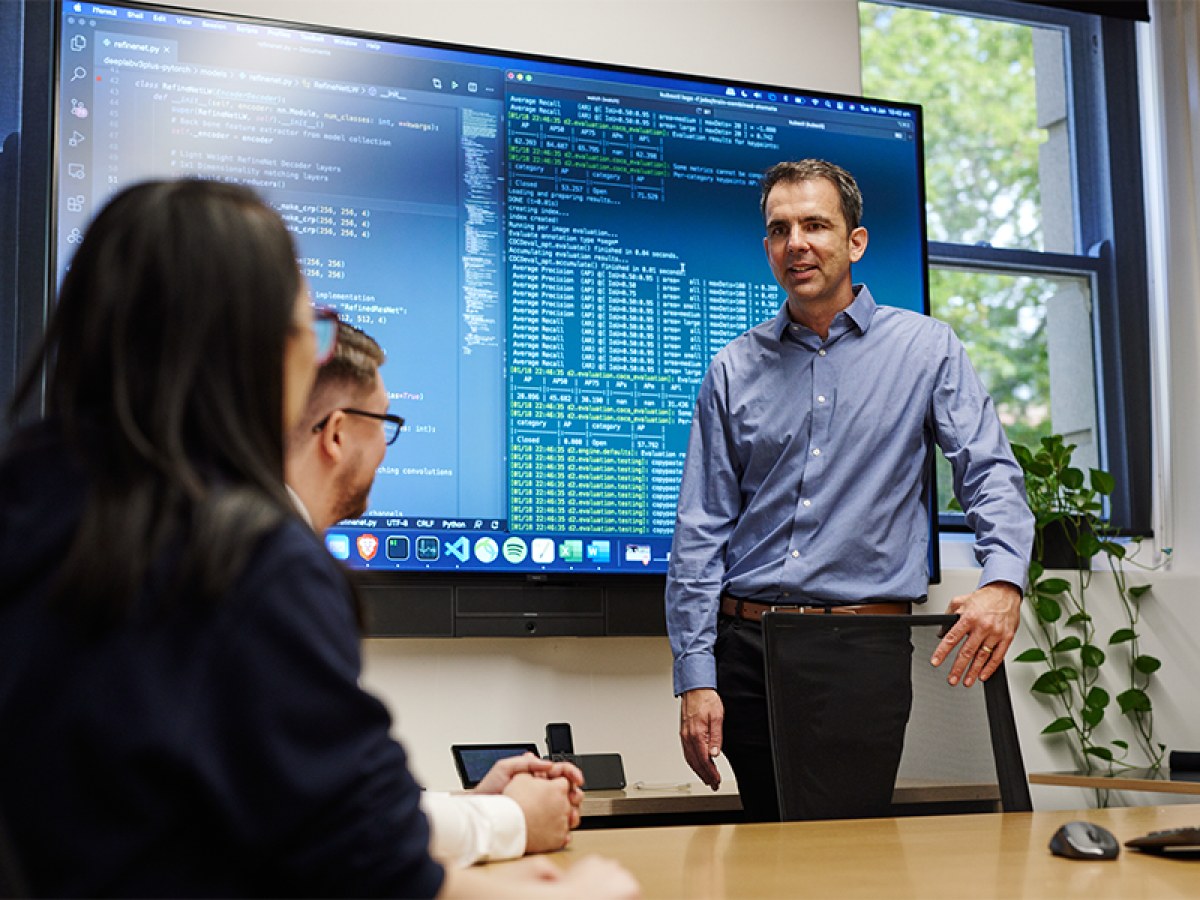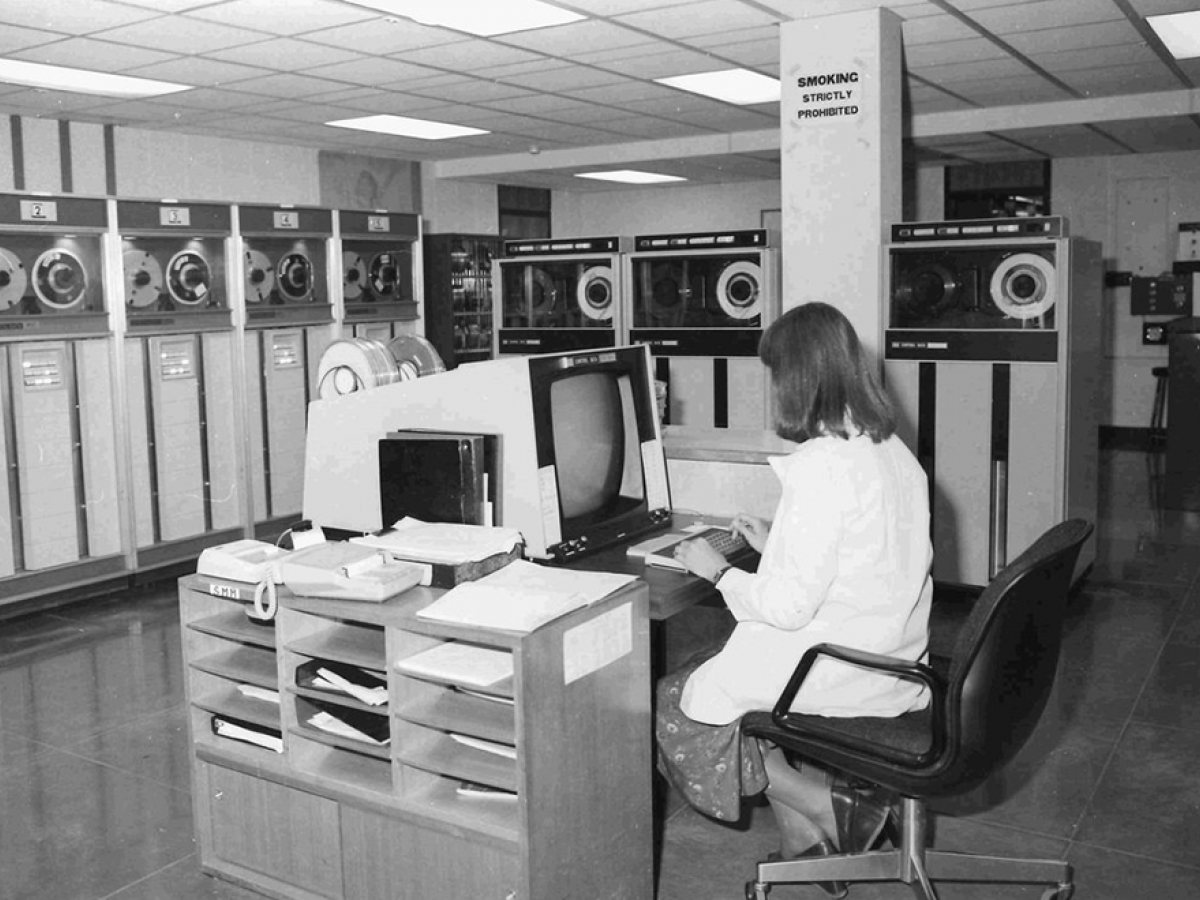AI: The Lumen interview

AIML Director, Professor Simon Lucey
The world has been captivated this year with rapid advances in artificial intelligence (AI). Recent innovations in generative AI such as Dall-E 2 or Midjourney, and natural language processing models such as ChatGPT, are changing the way we live, work and study. Many are concerned about what this will mean for our future, whereas others are optimistic about what the technology will allow us to do.
In this special interview, Simon Lucey, Director of the Australian Institute for Machine Learning (AIML), and a Professor in the University of Adelaide’s School of Computer and Mathematical Sciences, clarifies concerns and explains the opportunities for Australia to shape the future by embracing AI.
How have we arrived where we are now with AI?
There was an American researcher named Frank Rosenblatt who, in the late 1950s, built a machine he called the perceptron which almost predated computers.This complicated machine had resistors which, if tuned correctly, could accurately identify pictures of symbols such as ‘A’ or ‘B’. This captured the attention of the US military and media, and for a while people were saying computers will mimic everything we as humans can do, very reminiscent of what we are hearing now. Attention fell away for several decades, but was recaptured around 2010 with the rise of a type of AI called deep learning.
I think we are very much still in the early stages of AI. We are at a point where the advantages of AI from a commercial standpoint are forming. Like electricity or the internet, I think AI is going to be everywhere. This is similar to the invention of the electric telegraph, in which people were starting to make money from the ability to communicate over large distances with little idea of the principles such communication should serve or how it worked.
The telegraph then led to information theory, computers, and things you could not have seen coming at that time. What we are doing right now people will look back on as archaic. We are in our telegraph moment.
What practical uses does AI have for Australians?
I think a lot of Australians are already working with AI and do not realise it. Anyone who uses a search engine is using some type of AI under the hood. If you talk into your watch or your phone, that’s using AI. We are seeing new uses for AI, the big one everyone’s aware of and loves to speak about lately is ChatGPT.
I worked a lot in the autonomous car industry which, like ChatGPT now, everyone was talking about. It has been on the backburner in recent times, but I think that’s a long burn that you will see a lot more of in the future. Not necessarily cars driving by themselves, but instead more of the driver’s role being passed over to the car.
Features such as lane assistance and collision detection are some examples of ways Australians have already been touched by AI.
Much like electricity or the internet, AI is going to be everywhere.
I think that the sign any good technology has made it is when you don’t notice it anymore. Our children will be in a situation where AI is everywhere, like electricity. We’re going to be surprised one day about the things we once had to do manually.

The Australian Institute of Machine Learning (AIML), Lot Fourteen, North Terrace. Photo by Josh Geelen
How will AI impact the future of work and employment?
This sometimes causes a lot of fear because human society has gone through much change throughout the different eras of industrial revolution. This caused a lot of displacement such as manufacturing moving offshore. With any type of industrial change, you will see angst, but what’s interesting is that with AI it’s hard to predict where.
I think it’s more white collar than blue collar jobs that are going to be affected first. There’s a classic problem in robotics called the universal grasping problem or manipulation problem. It’s difficult to get any robot or machine to pick up any object universally. We take this for granted as humans. Most things that are roboticised or mechanised are very closed and focused on one repetitive task. Humans are amazing in our ability to carry out many different tasks under different scenarios.
Interestingly, we are already familiar with change in white collar jobs. What I was doing when I started my job is very different to what I do now.There is an opportunity for AI to be used as a productivity tool in situations that do not rely on any high-risk decisions like legal defence or performing surgery. For those decisions you still need a human in the loop.
AI is great for productivity, and could be a net job creator, especially in Western countries like Australia. There is a lot of fear over job losses, but I believe they’re largely unfounded. All Western countries are getting greyer and older; we’re going to need productivity tools to keep the economy ticking along. There will be disruption, but I think the pace that it will occur, and the type of disruption, may be overblown. AI is potentially a job creator.
Australia needs to invest in AI just so we can tread water, so we do not lose jobs to other countries investing in AI. If we invest strategically, we could achieve job growth and bring back the jobs lost through globalisation. The reason those jobs left is because of the cost of labour, and so automation reduces those costs. Burying our heads in the sand saying ‘this is scary, we hate it, we’re worried, let’s not do anything’, is a catastrophic decision for the country because that will lead to a less complex economy, poor productivity, and fundamentally a lack of opportunity for the next generation of young Australians.
What is AIML doing to advance AI?
One of the big challenges with AI is how well it can mimic what humans can do, but AI does not learn like humans. AI works on frequency of data, let’s say I am deploying a robot to Mars, there will not be a lot of data on that. Autonomous vehicles for example have been exposed to millions of hours of driving time, yet they still cannot drive like a human. Whereas a 17-year-old in South Australia only needs 75 or so hours behind a wheel. Our focus at AIML is to get AI to not just perform like humans but to learn like humans so they can go out and do different things.
We are ranked in the top 10 in the world in computer vision, which is impressive considering other institutes are in superpower countries like the US or China. I was a professor in the US for 15 years, and it’s the reason I came back to Adelaide, because nowhere else in the country is similar and AIML had that global reputation.
We are also strong in something called vision-and-language which is the intersection between computer vision and natural language processing. Say you have a robot deployed somewhere and you tell it that you want it to move to an object somewhere else; that uses vision and language components together.
We are leading in the issue of correlation and causality. I always bring my umbrella when it is raining, that’s correlated together. If I bring my umbrella into my office, that does not mean it will rain, that’s causality. Humans are great at determining if it is likely to rain and what to do about it, machines don’t necessarily do reasoning and the counterfactuals that humans do. Machines are great at rote memorisation en masse but they’re only as good as the data they have been exposed to.

Our University’s then state-of-the-art computer lab in the 1970s. In comparison, Open AI’s supercomputer (Open AI is the company behind AI programs such as ChatGPT) recently built in collaboration with Microsoft cost $1 billon with more than 285,000 CPU cores, 10,000 GPUs and 400 gigabits per second of network connectivity for each GPU server
What are some of the greatest challenges ahead?
We project our human view of intelligence onto the machine. We ask ourselves ‘if I was a super intelligent entity what would I do?’ Take over the world? That’s a human projection.
Fear of what AI is and what it can do is a challenge. Another is misunderstanding what AI is good at and not good at. With large language models like ChatGPT, it’s a fantastic tool, but if it’s used in the wrong way, such as asking it about your love life, it’s dangerous. When used for things like ‘write me a letter intended for a student, that I need to inform them of an issue with their homework’ and make edits, it’s good.
We tend to use the word intelligence and try to project our human definition of intelligence onto the machine. It’s intelligent, but in a certain way, and knowing when and when not to use it is important.
How do we combat these challenges?
There’s a big area in AI at the moment called alignment. They’re trying to align AI with human values – I think that’s really going to drive it forward. At AIML and the University of Adelaide, we’re interested in the narratives around responsible AI. Such as how we can make sure that AI is being used responsibly, has guardrails, where it should and shouldn’t be used, where it is weak; all things industries need to know to invest strategically. AIML’s role, and the University’s role, is advising government and industry what the opportunities are and how to maximise them.
Innovation, and the models that you would have used in, say, 2017-18, have remained remarkably similar to what we’re seeing now. What has changed dramatically is the amount of data and computers, a lot of companies are calling this scale. It is essentially the number of numbers in the neural network. If we can scale that, the belief is we get more emergent behaviour. Perhaps GPT-3 couldn’t pass the Bar exam, but GPT-4 can.
Should we be hesitant to adopt it so quickly considering the challenges?
It would be catastrophic for Australia to leave AI up to other countries. It will be more like electricity or the internet but on steroids. It will permeate everything, including how we work, how we consume media, even how democracies run.
We want our values projected into the future, and if we do not have a seat at the table with respect to innovation of AI, our voices will be drowned out.
Social media, as an example, brought a lot of good, but it’s been a bit of a catastrophe, too, in terms of social democracy.
There will always be bad and good use cases, but we cannot put our head in the sand and stop because the world isn’t going to stop, nor are bad actors.
We need to progress and project the future that we want to see, and ensure we have a seat at the table, ensuring that guardrails from a legal standpoint are in place, and that we have allies working with us for this.
Australia has amplified itself as a middle power by leading through alliances. Australia has a voice and a role to play, and by leading and benefitting from the technology, we can amplify our voice.
Interview by Lachlan Wallace, Communications Assistant for the University of Adelaide.
The Australian Institute for Machine Learning (AIML) is Australia’s first institute dedicated to research in machine learning. The institute was established as a partnership between the University of Adelaide and the Government of South Australia.
